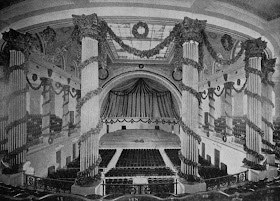The history and success of the Chicago Symphony Orchestra is closely intertwined with the lives of John and Frances Glessner. The founding conductor, Theodore Thomas (shown above) was an intimate friend of the couple for many years, and he consulted with them frequently on all matters relating to the orchestra.
Thomas first came to Chicago Chicago Chicago
It is not known exactly how and when the Glessners and Thomas became acquainted, but by the time of formation of the orchestra in 1891, John Glessner was one of 50 guarantors who each provided $1,000 annually against losses (which were considerable in the early years).
Thomas was appointed Music Director in the Bureau of Music at the World’s Columbian Exposition, and Music Hall (shown above) was constructed for his use. The Fair proved a trying time for Thomas, who was inadvertently drawn into the politics of the fair, in regards to policies implemented to forbid the use of any instruments made by manufacturers who did not exhibit at the fair (including Steinway). Thomas felt strongly that his guest artists, including Ignace Paderewski and Camille Saint-Saens, should be allowed to play the instruments of their choosing. The Glessners were staunch supporters of Thomas throughout the ordeal, which resulted in his resignation in August 1893. In time the whole episode was forgotten, and by May 1895, Frances Glessner headed up a group of thirty-six ladies in Chicago
By 1898, when John Glessner was elected a trustee of the Orchestral Association, he had contributed over $7,200 to the orchestra, making him one of the four largest donors to date. He remained a trustee until his death in 1936 and for the last twenty years of his life served on the Executive Committee. Frances Glessner was one of the founders of the Chicago Chamber Music Society, an arm of the orchestra, and served on its executive committee for many years.
Away from Chicago New Hampshire
Members of the orchestra frequently entertained at the Glessner home, providing music for dinner parties and meetings of the Monday Morning Reading Class. On more than one occasion, Thomas brought musicians by surprise to the Glessner house for a birthday or anniversary. The Glessners reciprocated by providing wonderful receptions and dinners for the musicians, and on more than one occasion hosted the entire orchestra for a sit down dinner. One of these times was in January 1913, when the members of the orchestra were able to view the meticulously executed miniature orchestra that Frances Glessner Lee had made herself, a birthday gift to her mother.
In 1902, when the time came to realize the long-held dream of Theodore Thomas to construct a permanent hall for the orchestra, John Glessner, along with Daniel Burnham and Bryan Lathrop, held the title for the newly purchased property on Michigan Avenue. These three men, along with seven other trustees, carried the entire purchase price, by cash and their personal notes, until 1905, when the Association secured a loan for the completion of orchestra hall. The Glessners were instrumental in raising a significant portion of the funds needed to construct the hall, which opened in December 1904. They were assigned Box M in the new hall (shown above), directly behind the conductor’s podium, and it was reserved for their exclusive use until their deaths in the 1930s.
Less than one month after the opening of the new hall, Theodore Thomas died. His wife and the Glessners were the only ones at the bedside. After his passing, George Glessner was summoned and took post-mortem photographs, presumably given to the widow. Soon after the funeral, Thomas’ widow Rose presented the Glessners with his baton and a preserved palm frond from his casket, mementoes of their long friendship. (The pieces remain on view today in the museum, in the hallway outside the master bedroom).
The relationship with the orchestra remained close under Thomas’ successor, Frederick Stock. On December 31, 19 09America
John Glessner died on January 20, 19 36



No comments:
Post a Comment